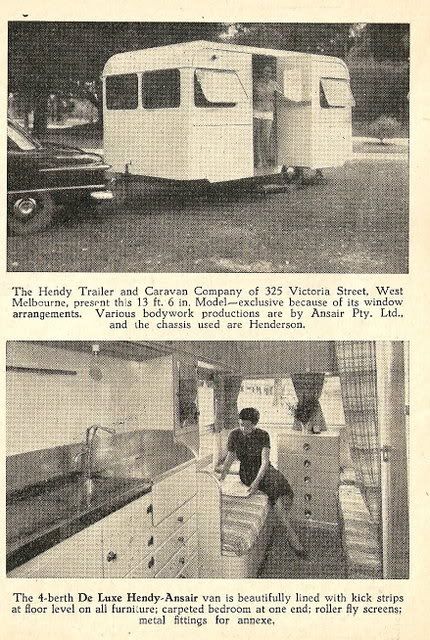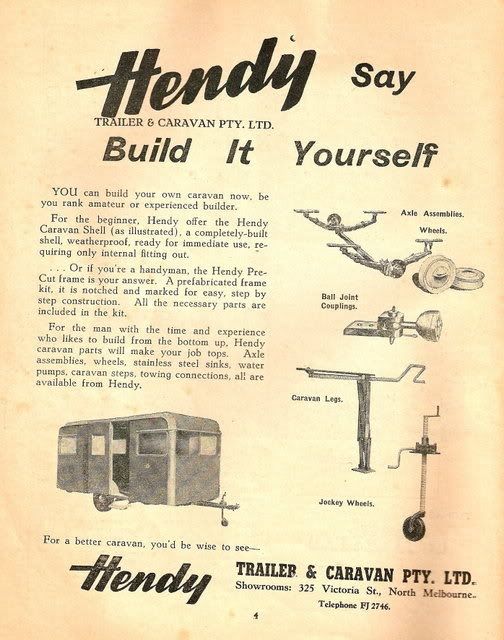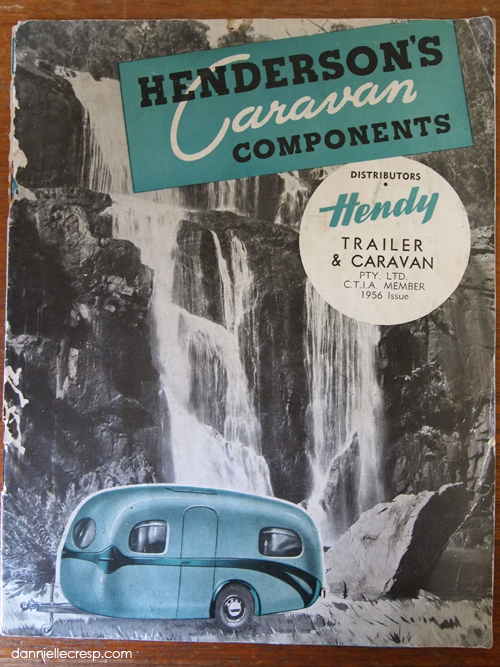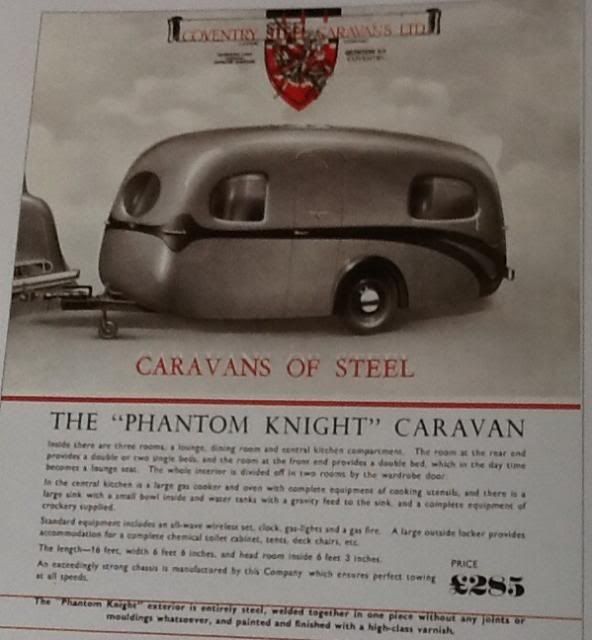|
|
Post by cobber on Nov 8, 2008 7:30:41 GMT 10
Hendy Trailer and Caravan Company (The), Victoria St. North Melbourne. From the 1954 Australian Caravan & Touring manual. According to the “Specification” page they also had an 11ft model made of masonite.... no mention of this 13ft model in Specs. page    Cobber. |
|
|
|
Post by Don Ricardo on Nov 8, 2008 12:04:42 GMT 10
Hi Cobber,
I note that Hendy built its caravans in conjuction with Ansair. Ansair built long distance coaches for Ansett, and in the 1956 edition of Winser, is also shown as building vans for Courtney Caravans.
The 13' 6" Hendy looks not unlike a Carapark in style. The corners of the van look to be conventional right angle joins, but the edges of the roof appear to be fairly tightly curved. I wonder if that indicates that at least the roof was aluminium?
Don Ricardo
|
|
|
|
Post by cobber on Nov 8, 2008 13:36:09 GMT 10
G'day Don,
I can't find any other reference to the 13' 6" "Hendy" to determine if it was also made of Masonite or not but... looking at the second photo above there appears to be a timber frame work supporting the roof, which sort of indicates it was timber of some sort.
Sure looks like a Carapark eh?
Cobber.
|
|
|
|
Post by sportsman 1 on Nov 8, 2008 14:13:21 GMT 10
That van appears to have Aluminium windows.
Have we been able to establish when ally windows were first fitted?
The Clipper has ally windows and I believe it was built in 1955. All the Clipper stuff I have seen shows wooden windows but I am positive my vans windows are original.
cheers, Leigh.
|
|
|
|
Post by cobber on Nov 8, 2008 14:35:04 GMT 10
|
|
|
|
Post by sportsman 1 on Nov 8, 2008 15:43:13 GMT 10
Thanks Cobber,
I shall have a read of that later. I thought that there was something somewhere about them but as I am at work I really didn't have much time to research.
The Clipper seems to be a really good quality build (more to come on that soon I hope) so it does not surprise me that it had ally windows so early. It just has the shape that sort of does not go with ally windows, if you know what I mean.
By the way I would check your last post, I am sure they were out before 1994/5!!!!!!!
|
|
|
|
Post by firefighter on Nov 9, 2008 19:11:36 GMT 10
|
|
dusty
Junior Member
 
Posts: 55
|
Post by dusty on Jan 3, 2013 12:24:46 GMT 10
This lady has copies of a 1950's Henderson/Hendy Caravan Components catalogue on her blog. Not a lot of info - well, no info on caravans - it's all trailers. But still may be worth a look for anybody interested in Henderson of West Melbourne. www.danniellecresp.com/2012/02/inspiration-1950s-catalogue/ |
|
|
|
Post by cobber on Jun 5, 2014 13:32:26 GMT 10
It is interesting to note (I think  ) that the caravan shown in the above 'Henderson' / 'Hendy' advertisement is in fact an English made Coventry Steel ' Phantom Knight' caravan, made by Clifford Dawtrey in 1938 ( the bloke who previously had made 'Airlite caravans') The van is actually made of steel, why they used an English caravan in a 1956 Add. when this actual 'Phantom Knight' van was only made for one year in 1938   Cobber. |
|
|
|
Post by Surf Tragic on Jun 5, 2014 18:52:32 GMT 10
G'day Cobber
Pretty interesting to see a steel van I have never seen or heard of one before today, The curvy body style is 'car-like'. If there were only a few manufactured, you would assume it would have been labour intensive, can't imagine them punching out panels with expensive presses, would they? Also wonder about the weight, being steel. I could (hardly) read the print on the brochure, but couldn't see any specifications. ST
|
|
|
|
Post by cobber on Jun 5, 2014 20:20:26 GMT 10
G'day ST, Clifford Dawdrey was an interesting, but flawed bloke, in the 1930s and 1950 during the evolution of English caravans he came up with some very interesting and innovative designs. After Airlite folded in 1938 he bought Coventry Steel and produced the all steel bodied 'Phantom Knight' caravan. It is described as ''having rolled-out sections welded together to produce a smooth one piece shell with no mouldings. The edges of the rolled sections were turned in to carry wooden fillets for mounting the inner panelling and furniture ---- He soon realised he had to abandon steel in favour of aluminium due to the excessive weight. " The aluminium model weighed about 3cwt less. He went on to produce various other shapes and sizes and then the War intervened. During the War years he made ambulances for the War effort and in 1946 resumed caravan production. But that particular 'Phantom Knight' never made another appearance. He took his own life in 1958 after his latest design was a sales flop. I have not seen reference to the actual weight of the Phantom Knight but at 16ft. In length she would not have been a feather weight aye ? The above quotes come from two books, 'British Caravans, Volume 1: Makes founded before World War II ' and 'The History of the CARAVAN' Both books have much more to say about Clifford Dawtrey and Coventry Steel but you get the idea behind the construction of the 'Phantom Knight'  Cobber. |
|
|
|
Post by Surf Tragic on Jun 6, 2014 0:14:23 GMT 10
, G'day ST, It is described as ''having rolled-out sections welded together to produce a smooth one piece shell with no mouldings. The edges of the rolled sections were turned in to carry wooden fillets for mounting the inner panelling and furniture ---- Cobber. Cobber, So that's how it was done! really top stuff. It sounds like real coach building/ body building using a huge steel wheel, I have seen it done in a documentary using an " English Wheel" to " panel beat" & form sheet metal. Maybe that is how it was done, very skillful & I admire the skill. There would be some members on this forum who would very likely have done a bit in their day, and still do, on some of those Rods we have been privileged to see from time to time. What a shame it all stopped for this talented man. Thanks. ST |
|